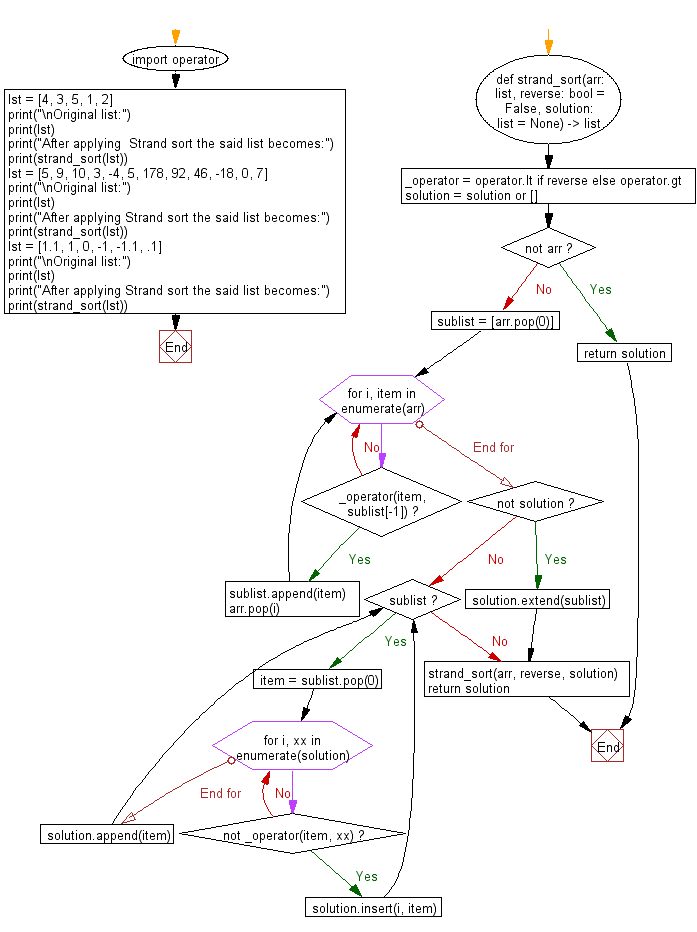Python: Sort unsorted numbers using Strand sort
26. Strand Sort
Write a Python program to sort unsorted numbers using Strand sort.
Strand sort is a recursive sorting algorithm that sorts items of a list into increasing order. It has O(n2) worst time complexity which occurs when the input list is reverse sorted. It has a best case time complexity of O(n) which occurs when the input is a list that is already sorted. Strand sort is not in-place as its space complexity is O(n).
Sample Solution:
Python Code:
#Ref:https://bit.ly/3qW9FIX
import operator
def strand_sort(arr: list, reverse: bool = False, solution: list = None) -> list:
_operator = operator.lt if reverse else operator.gt
solution = solution or []
if not arr:
return solution
sublist = [arr.pop(0)]
for i, item in enumerate(arr):
if _operator(item, sublist[-1]):
sublist.append(item)
arr.pop(i)
# merging sublist into solution list
if not solution:
solution.extend(sublist)
else:
while sublist:
item = sublist.pop(0)
for i, xx in enumerate(solution):
if not _operator(item, xx):
solution.insert(i, item)
break
else:
solution.append(item)
strand_sort(arr, reverse, solution)
return solution
lst = [4, 3, 5, 1, 2]
print("\nOriginal list:")
print(lst)
print("After applying Strand sort the said list becomes:")
print(strand_sort(lst))
lst = [5, 9, 10, 3, -4, 5, 178, 92, 46, -18, 0, 7]
print("\nOriginal list:")
print(lst)
print("After applying Strand sort the said list becomes:")
print(strand_sort(lst))
lst = [1.1, 1, 0, -1, -1.1, .1]
print("\nOriginal list:")
print(lst)
print("After applying Strand sort the said list becomes:")
print(strand_sort(lst))
Sample Output:
Original list: [4, 3, 5, 1, 2] After applying Strand sort the said list becomes: [1, 2, 3, 4, 5] Original list: [5, 9, 10, 3, -4, 5, 178, 92, 46, -18, 0, 7] After applying Strand sort the said list becomes: [-18, -4, 0, 3, 5, 5, 7, 9, 10, 46, 92, 178] Original list: [1.1, 1, 0, -1, -1.1, 0.1] After applying Strand sort the said list becomes: [-1.1, -1, 0, 0.1, 1, 1.1]
Flowchart:

For more Practice: Solve these Related Problems:
- Write a Python program to implement strand sort and display the sublists (strands) extracted during the sorting process.
- Write a Python script to perform strand sort on a list of numbers and then count the number of strands formed.
- Write a Python program to sort a list using strand sort and then merge the strands while printing intermediate results.
- Write a Python function to implement strand sort and then compare the sorted output with Python’s built-in sort.
Go to:
Previous: Write a Python program to sort unsorted numbers using Timsort.
Next: Write a Python program to sort unsorted numbers using Stooge sort.
Python Code Editor:
Contribute your code and comments through Disqus.
What is the difficulty level of this exercise?
Test your Programming skills with w3resource's quiz.
